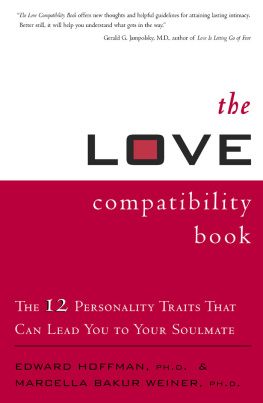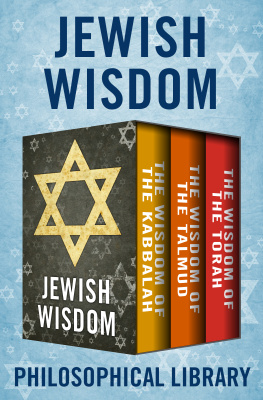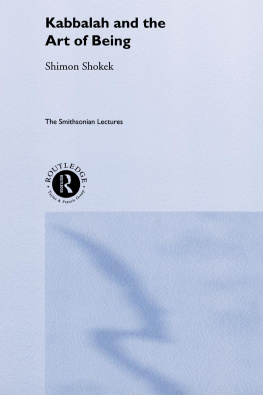THE
KABBALAH
DECK
PATHWAY TO THE SOUL
By Edward Hoffman

2000 Edward Hoffman
All rights reserved. No part of this book may be
reproduced in any form without written permission
from the publisher.
Also by Edward Hoffman: The Hebrew Alphabet:
A Mystical Journey and The Hebrew Alphabet Stamp Kit
eISBN: 978-0-8118-7314-7
Chronicle Books LLC
680 Second Street
San Francisco, CA 94107
www.chroniclebooks.com
Illustration and Calligraphy by Mickie Caspi
acknowledgements
This project would scarcely have been completed if not for the valuable help of others. Im grateful to Debra Lande, senior editor at Chronicle Books, for her initial and sustained enthusiasm throughout my effort; its been truly delightful working with her. Assistant Editor Jodi Davis has been consistently helpful. Im also indebted to Editor Alan Rapp for first introducing my Judaica work to his colleagues at Chronicle Books.
I wish to thank Sarah Axel, Harvey Gitlin, Cantor Bruce Halev, and Rabbi Neal Kaunfer for their varied conceptual contributions. Their sincerity, warmth, and insights are very much appreciated. Wide-ranging conversations with Steven Friedman, Dr. Steven Joseph, Dr. Sam Menahem, Paul Palnik, Mark Pearlman, and Gay and Howard Terry have also been important in helping me to meaningfully organize and present this material. My wife, Laurel, and our children, Aaron and Jeremy, have provided unflagging encouragement.
To all of the above, as well as to my Kabbalah teachers and students over the years, I wish to offer thanks and the hope that this project will enhance our inspiring dialogue and voyage together.

To the memory of
my grandfather,
Cantor Louis Lipitz,
who first taught me
Jewish spirituality.
contents
introduction
As never before, the KabbalahJudaisms mystical traditionis experiencing a tremendous rebirth of interest in the modern world. People of many different backgrounds and faiths are actively exploring this ancient system of knowledge about the human soul, the universe, and our relation to the divine. The Kabbalahs insights into inner growth and fulfillment in daily life are proving to be not only poetically inspiring, but personally relevant as well. Such global appeal, even in our high-tech era, isnt really surprising, for Jewish mystics have always viewed this sacred tradition as relevant to men and women of every generation.
And yet, there are definite reasons why the Kabbalah is now striking a particularly receptive chord. For one thing, we more clearly see the limitations of natural science and scientismthat is, viewing science as a religion. A half century after the horrors of World War II, only the most nacan still insist that scientific progress by itself will lead to a peaceful humanity; a strong ethical awareness is essential. At the same time, its become more apparent that the worlds great religious traditions are neither obsolete nor irrelevant, but rather speak to us in a timely manner.
Within the Jewish community, the Kabbalah has finally won its long-deserved respectability, due partly to the influential writings of Martin Buber and Gershom Scholem in modern Israel. Though striving with very different goals in mind, both were intellectual giants who clearly showed that mystical beliefs and practices have always been vital to Judaism. As a direct result, virtually all major universities now offer courses on the Kabbalah, albeit with an emphatically historical approach. Gone forever are the days when even Jewish history books ignored this sacred tradition or offered only a few, condescending words about it.
Responding to this new academic recognition, as well as to the changing spiritual needs of individual Jews, synagogues and adult-learning classes teaching the Kabbalah have become so acceptable as to be almost mainstream. In a manner unthinkable even a few years ago, rabbis, cantors, and lay educators are eagerly recruiting lecturers to explain what the hoopla surrounding Jewish mysticism is all about.
Perhaps ironically, the growth of psychology has also heightened interest in the Kabbalah and its relevance to understanding our inner world. With the exception of the Swiss psychiatrist Carl Jung, the key psychological founders were almost all anti-religious in their outlook. Under the influence of Sigmund Freud, nearly all social scientists rejected spiritual interest as the mark of the emotionally immature. For in Freuds view, religion had nothing positive to offer, and mystical experience was simply a delusional regression to the womb. This contemptuous attitude dominated for many decades.
Fortunately, the emergence of humanistic and transpersonal psychology has sparked a major change in attitude. Since the late 1960s, a growing number of counselors, therapists, and educators have been affirming that spirituality is an authenticand vitalaspect of human nature. As theorist Abraham Maslow aptly commented,The new image of the human psyche states that each of us has a higher nature and that this higher nature composes a basic part of our essence. Originating the term peak-experience to describe our loftiest, most sacred moments in life, Maslow called for a new embrace of religious wisdom through the ages.
For the past twenty years, Ive heeded Maslows call and focused specifically on Judaism. Beginning with my first volume in this field, The Way of Splendor, Ive sought to show how Jewish spiritual and mystical teachings can enhance our everyday lives in innumerable ways. In later books including Sparks of Light (co-authored with Rabbi Zalman M. Schacter-Shalomi), The Heavenly Ladder, Opening the Inner Gates, and most recently, The Hebrew Alphabet: A Mystical Journey, Ive presented additional Kabbalistic notions about the human soul and specific techniques, such as meditation, self-examination, and dreamwork, for better actualizing our inner potential.
Despite the encouraging reception these works have received, Ive increasingly felt the need for an entirely new resource one that would make the Kabbalah more dynamically personal and interactive. This format would certainly not replace classic study, but significantly complement it by providing a more experiential pathway into the proverbial garden of Jewish mystical guidance.
To this end, Ive created The Kabbalah Deck. Its been designed for two specific and not unrelated purposes. The first is for contemplation and sacred study, and the second is for divination. Both relate to the Thirty-Two Celestial Paths of the Kabbalistic system. Later in this book, well focus specifically on a variety of different exercises emanating from this basis for individual actualization, but for now, lets take a look at its essence.
THE THIRTY-TWO CELESTIAL PATHS
Throughout its vast history, the Kabbalah has presented many fascinating teachings about our relation to the divine. Undoubtedly, among the most importantand intriguingis that for each of us, thirty-two distinct pathways to the divine exist. The more clearly we understand these pathways, the greater our joy and fulfillment. Jewish sages and mystics have consistently identified the pathways as comprising the twenty-two letters of the Hebrew alphabet and the ten attributes of God known as the Sefirot in an array called the Tree of Life.
As far back as the fifth century C.E., the foundation of Jewish mysticism, known as the












